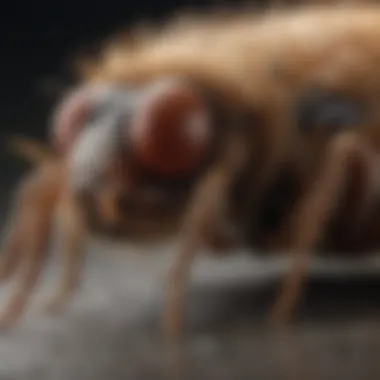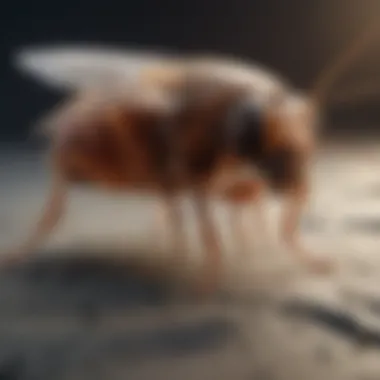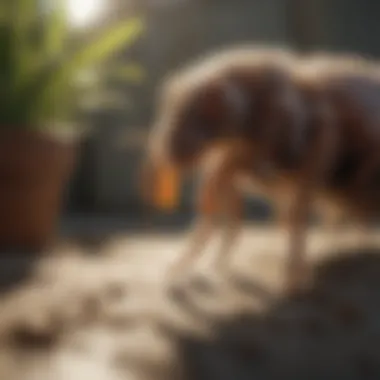Understanding and Managing Backyard Flea Infestation


Intro
Flea infestations in residential backyards are often underestimated, yet they can pose significant challenges for homeowners. Fleas are not merely an annoyance; they can affect not only pets but also human occupants. Understanding how to identify these pests, manage infestations, and implement effective prevention strategies is crucial for maintaining a comfortable living environment.
This article will delve into essential concepts related to flea biology and behavior, contributing to a well-rounded understanding of their impact on home life. Knowing how to recognize fleas early can save time, money, and discomfort. We will explore various ways to prevent infestations from taking hold, as well as examine natural and DIY treatment solutions.
As you navigate through this guide, it is important to glean actionable insights that can transform a potentially overwhelming pest management task into a systematic approach to safeguarding your home. Let's begin.
Prelims to Flea Infestations
Flea infestations in backyards present a significant challenge for homeowners. Understanding this issue is not just about pest control; it is crucial for the well-being of your family and pets. Fleas can affect health and cause discomfort, making it imperative to address infestations promptly.
The section leads to a deeper comprehension of what constitutes a flea infestation. It offers insights into the menace fleas pose, explaining the implications of their presence in residential spaces. Most importantly, this lays the foundation for effective management techniques.
Definition of a Flea Infestation
A flea infestation is characterized by a significant presence of fleas in an environment, particularly in areas frequented by pets or humans. Fleas are small, wingless insects that feed on the blood of mammals and birds. Their ability to reproduce rapidly complicates the infestation, as a few fleas can multiply into hundreds or thousands in a short time.
The primary types of fleas that invade backyards include the cat flea, dog flea, and human flea. Each type has specific behaviors and preferences but shares the common trait of affecting domestic life. When fleas infest an area, they not only cause itching and irritation but can also transmit various diseases, impacting overall health.
Common Signs of Infestation
Identifying flea infestations early is essential to managing them effectively. Here are some common signs to look for:
- Flea bites on pets: Bites usually appear as red bumps on your pet's skin, often leading to scratching.
- Flea dirt: Dark specks in your pet's fur or in areas where they rest, usually indicating flea waste.
- Behavioral changes: Increased scratching, biting at the skin, or restlessness in pets can signify an infestation.
- Visible fleas: Small, agile insects moving in the pet's fur or bedding.
Early detection allows for more straightforward solutions, minimizing the health risks associated with fleas.
Maintaining vigilance for these signs ensures you can take action before the situation escalates. By staying informed and proactive, homeowners can mitigate the impact of flea infestations effectively.
Understanding Flea Biology
Flea biology is essential to understanding how to effectively manage an infestation. Knowing their life stages, behaviors, and preferred habitats enables homeowners to target their prevention and treatment efforts better. This knowledge helps in developing a comprehensive strategy against fleas that not only addresses the immediate problem but also reduces the likelihood of future infestations.
Life Cycle of Fleas
The life cycle of fleas comprises four distinct stages: eggs, larvae, pupae, and adults. Understanding these stages provides insight into their development and behavior, which is crucial for effective management. Each stage has its characteristics and challenges, and recognizing these can significantly enhance control methods.
Egg Stage
Flea eggs are the starting point of the life cycle. They are small, white, and often indistinguishable from dust when present in your home. A female flea can lay up to 50 eggs per day, leading to rapid population growth. The sheer volume of eggs produced makes this stage critical because it lays the foundation for later infestations.
One significant aspect of the egg stage is its ability to hatch in a wide range of conditions, often within 2 to 14 days. This adaptability allows fleas to increase in number even in sub-optimal environments, contributing to persistent problems. Therefore, managing the environment in which fleas lay eggs can be beneficial.
Lava Stage
The larvae, or lavae, emerge from the eggs. They are small, white, and worm-like in appearance. This stage is vital as the larvae feed on organic debris, including adult flea feces, which contain undigested blood. This reliance on an organic diet means that areas with pets will often see higher larval populations.
The unique feature of this stage is its development within dark, undisturbed spaces, like cracks in your floor or hidden areas in the yard. This behavior makes it challenging to target larvae, as standard treatment methods may not reach these hotspots. Consequently, understanding how and where larvae thrive helps in planning effective treatments.
Pupa Stage
The pupal stage is where flea larvae create a cocoon and enter a semi-dormant state. This stage is intriguing because the pupae can remain dormant for several months, waiting for the right stimuli, such as heat and movement, to hatch. This ability is a crucial survival mechanism.
When discussing the advantages and disadvantages, it is critical to note that while pupae can withstand adverse conditions, they can also present a challenge for homeowners trying to manage infestations. This stage makes it possible for fleas to survive long periods without a host, thus complicating eradication efforts.
Adult Stage
Adult fleas are the most recognized stage, notorious for their bites on pets and humans. They are brown, flattened, and can jump great distances. Adult fleas require a blood meal to reproduce, which makes them the most visible and problematic of all life stages.
One of the key characteristics of adult fleas is their reproduction rate. A single flea can produce thousands of offspring in its lifetime. This prolific nature emphasizes the importance of swift and comprehensive treatment strategies. Tackling adults is often necessary, but if the eggs, larvae, and pupae are ignored, reinfestation is likely.
Flea Behavior and Habitat
Flea behavior and their preferred habitats play a significant role in understanding infestation management. Fleas prefer dark, warm, and humid environments which provide a conducive atmosphere for their development.
Preferred Environments
Fleas typically thrive in areas where pets reside. They prefer grassy lawns, shaded areas, and any clutter where they can hide and breed. Given their social structure, fleas will often jump from one host to another if presented with the chance.
Recognizing the environmental needs of fleas is beneficial because it allows property owners to identify potential breeding ground spots. Implementing cleaning routines and yard maintenance can disrupt their breeding cycle. Regular lawn care and sanitizing pet areas can significantly hinder flea populations.
Feeding Habits


Flea feeding habits are central to understanding their lifecycle. Adult fleas consume blood from their hosts to sustain themselves and reproduce. They have specialized mouthparts that enable them to penetrate skin and feed on blood.
This can lead to several issues, especially for pets. Fleas may transmit diseases through their bite and cause allergic reactions in sensitive individuals. Managing feeding habits through proper pet treatment and environmental control helps mitigate these risks.
Reproductive Patterns
Fleas have a rapid reproductive cycle that contributes to infestation challenges. An adult female flea can lay eggs shortly after a blood meal. This cycle accelerates infestation potential and makes timely management crucial.
Understanding flea reproductive patterns aids in identifying when and where interventions will be most effective. Appropriate use of flea control products during peak reproductive times can reduce future infestations significantly.
In summary, understanding flea biology, including their life cycle, behaviors, and habitat preferences, enhances management strategies. Homeowners gain insight into the conditions that facilitate flea growth, enabling them to create strategies that disrupt this cycle.
Identifying Fleas in Your Backyard
Identifying fleas in your backyard is crucial for effective pest management. Early detection helps in mitigating potential damage before it spreads. Fleas reproduce quickly, leading to a larger infestation if not addressed promptly. Knowing how to recognize fleas can save both time and resources in controlling their population. This section will provide techniques and tools that can simplify the identification process, benefiting homeowners and pet owners alike.
Visual Identification Techniques
Recognizing fleas through visual techniques allows homeowners to take immediate action. Understanding physical characteristics is essential for successfully identifying these pests.
Body Shape and Size
Fleas are small, wingless insects that have a distinct shape. They typically measure around 1/16 to 1/8 of an inch in length. Their bodies are laterally flattened, which allows them to move easily through fur or grass. This aspect is important because the unique body shape helps distinguish fleas from other insects. When looking for them, pay attention to this defining feature.
The small size of fleas makes them hard to spot. However, knowing their dimensions helps identify their presence in your backyard. While their size can be a disadvantage for detection, understanding it aids in recognizing other signs of infestation, such as flea dirt or bites on pets.
Coloration
Fleas are often dark brown or reddish-brown in color. This coloration aids in blending with their environment, making them harder to notice. The key characteristic of their color is its ability to camouflage effectively. This makes it more challenging to identify fleas visually.
In light conditions, one might miss them easily. However, the contrast of the fleas against a light background, like white socks, can make them seem more visible. Thus, understanding their color can be beneficial in improving detection strategies.
Movement Patterns
Fleas are notably agile. They can jump up to 150 times their body length. Their movement patterns are erratic and quick, which can be indicative of their presence. Observing where they congregate or move is important. A key element of their activity is that they tend to be more active in warmer and humid conditions.
Moving quickly from one host to another, fleas can be challenging to catch. Recognizing these patterns is crucial for understanding their behavior. It also helps in planning an effective response to reduce their numbers in your backyard.
Tools for Detection
While visual techniques are useful, having tools for detection can enhance identification efforts. The following tools can assist in finding fleas more effectively.
Flea Comb
A flea comb is a valuable tool for pet owners. This comb has fine teeth designed to catch fleas and flea dirt easily. By combing through your pet's fur, you can directly identify the presence of fleas. This method allows for a thorough examination and can provide immediate results.
The advantage of using a flea comb is its simplicity and effectiveness. It is a non-chemical approach that can be done daily. However, if your pet has a thick coat, it may take longer to identify fleas thoroughly.
White Socks Test
The White Socks Test is a straightforward method to detect fleas in your backyard. By wearing white socks and walking through grass or your garden, you can more easily notice any fleas that jump onto your socks. This method highlights how fleas can be spotted more efficiently against a light background.
It is a low-cost technique requiring minimal preparation. However, it might require consistent checks to be effective, especially in larger areas.
Visual Inspection Methods
Visual inspection methods involve scanning your backyard for signs of fleas. Look for flea dirt, which appears as tiny black specks, often found in areas where pets rest. Checking around pet bedding or common play areas can be quite helpful.
This approach promotes awareness of the overall situation in your yard. It encourages regular monitoring, which is advantageous for early identification. However, it may not always yield immediate results, particularly in large yards or less obvious areas.
Impacts of Flea Infestation
Understanding the impacts of flea infestation is crucial for homeowners. Fleas do more than annoy; they can lead to significant health and behavioral issues for pets, as well as potential health problems for humans. The adverse effects highlight the need for prompt identification and remediation.
Effects on Pets
Health Issues
Health issues arising from flea infestations primarily include skin allergies and infections. Flea bites cause intense itching, which can lead pets to scratch excessively. This behavior can result in skin irritation or infections, putting the pet at higher risk for more severe health concerns. Furthermore, fleas can transmit serious diseases such as flea anemia, especially in young or elderly animals, where the blood loss can be critical. Understanding these health implications is vital for creating a strategy that protects pets and maintains their well-being. The key characteristic here is the potential for serious health ramifications that can escalate if the infestation remains unmanaged.
Behavioral Changes
Behavioral changes in pets due to flea infestations can manifest as increased irritability or agitation. Pets may become restless as they attempt to relieve themselves from the discomfort caused by flea bites. This change in behavior can be distressing for both pets and owners. Additionally, infested pets often become more withdrawn or less playful, which can indicate a need for intervention. Identifying these changes early is important. The unique feature of behavioral changes is that they often offer the first visible clue to an infestation. Pets rely on their owners to recognize these cues, making awareness essential for timely treatment.
Effects on Humans


Allergic Reactions
Humans can also suffer from allergic reactions caused by flea bites. Symptoms range from localized swelling and itching to more severe reactions in susceptible individuals. These reactions can significantly detract from one’s quality of life, necessitating additional care and sometimes medication. Recognizing allergic reactions as a common effect of flea infestations is crucial for households with pets. The sensitivity of certain individuals makes addressing this issue a priority.
Parasite Transmission
Fleas can transmit various parasites, such as tapeworms, between hosts, and this poses a risk not only to pets but to humans as well. When fleas bite, they can leave behind eggs that may inadvertently be ingested by pets or children during normal grooming or play. This possibility illustrates a direct link between flea infestations and broader health concerns. Highlighting this transmission risk emphasizes the urgency of flea management in residential areas. The unique feature here is that parasite transmission can have long-term health implications, reinforcing the need for a robust approach to flea control in the home.
Treatment Options for Fleas
Treatment options for fleas are crucial in effectively managing and eliminating infestations. Homeowners must consider both chemical and natural remedies. It is vital to weigh the benefits and potential drawbacks of each option. The goal is to find a solution that aligns with personal preferences and environmental impacts.
Chemical Solutions
Chemical solutions often provide immediate effects against fleas. While some may prefer natural methods, the potency of chemical options can be compelling. Keeping a balanced approach is key when considering these treatments.
Flea Sprays
Flea sprays are a popular choice due to their broad availability. They are designed to eliminate fleas on contact. A key characteristic of flea sprays is their quick action. This makes them suitable for immediate relief in affected areas.
Flea sprays often contain insect growth regulators, or IGRs, which help prevent future flea development. However, while effective, they can have downsides. Some sprays may contain chemicals that are harsh on indoor air quality. Therefore, it is important to ventilate the area after application to minimize exposure. Consider safety precautions if pets or children are present.
Foggers
Foggers work by releasing a mist that spreads throughout the environment. This makes them effective for treating larger areas, such as backyards or multiple rooms. A significant advantage of foggers is their ability to reach hidden spaces that may be hard to spray directly.
However, foggers also have drawbacks. They may require vacating the premises during treatment, making them less convenient. Moreover, precautionary measures are essential to protect pets and human health during and after use. The effectiveness can vary based on thoroughness in following instructions.
Granular Treatments
Granular treatments are another chemical option that can be spread directly over the infested area. The key characteristic is their long-lasting effect. Once applied, they can gradually kill fleas over time. This feature can be beneficial for ongoing infestations or as a preventive measure.
Yet, granular treatments could be confusing to apply correctly. Uneven distribution may lead to suboptimal results. Homeowners should ensure that they follow usage instructions closely for the best effect. It is also wise to consider the surrounding environment, as runoff can impact local ecosystems.
Natural Remedies
Natural remedies are often viewed as safer alternatives to chemical treatments. Homeowners may choose these for environmental reasons or to avoid chemicals around children and pets. However, effectiveness could vary.
Essential Oils
Essential oils, such as lavender and peppermint, are popular for their repellent properties. They are appealing for those preferring a natural approach. The key aspect is their pleasant scent, which can also deter fleas.
However, essential oils must be used cautiously. They should be diluted properly, as concentrated forms can be harmful. Additionally, the effectiveness of essential oils in entirely eliminating infestations remains a topic of debate. Some might find mixed results.
Diatomaceous Earth
Diatomaceous earth is a fine powder made from fossilized algal remains. When sprinkled in the yard or around the house, it can be effective in controlling fleas. The key characteristic is that it works mechanically, cutting through the flea's exoskeleton and dehydrating them. This makes it a safer choice for homes with children and pets.
While effective, its success depends on proper application. Even distribution is necessary to ensure fleas come into contact with it. Additionally, it can take time to see results. Some may find that they need to combine this method with others to achieve desired outcomes.
Homemade Flea Solutions
Homemade flea solutions are often viewed as cost-friendly and customizable. These solutions can include mixtures of soap and water or vinegar-based sprays. The key benefit is control over the ingredients, which can be tailored to personal preferences and sensitivities.
Nevertheless, it is important to note that homemade solutions can be less potent than commercial options. Their effectiveness can also depend on a multitude of factors, such as flea life cycle stages and the extent of the infestation. Homeowners should use these solutions with realistic expectations.
In summary, whether one chooses chemical solutions or natural remedies, the treatment of flea infestations warrants careful consideration. Homeowners must evaluate the effectiveness, potential risks, and overall impact of the chosen treatment methods.
Preventing Future Infestations
Preventing flea infestations is crucial for any homeowner or pet owner dealing with the persistent and often frustrating problem of these pests. It involves a strategic approach that encompasses both environmental management and the use of preventative products. Understanding this proactive stance not only helps in maintaining a flea-free backyard but also safeguards the health and comfort of pets and family members. Effective prevention reduces the risk of future outbreaks, ensuring a lasting solution rather than temporary fixes.
Maintaining a Clean Environment
A clean environment is the first line of defense against fleas. Regular care and upkeep of the backyard can significantly decrease the likelihood of an infestation. By creating a less hospitable habitat for fleas, homeowners can effectively manage their presence.
Regular Lawn Care
Regular lawn care refers to the systematic maintenance of grassy areas in the backyard. This practice is essential as it directly impacts flea populations. Frequent mowing of grass reduces hiding spots for adult fleas and their larvae, discouraging their presence.
The key characteristic of regular lawn care is its routine nature, which makes it a sustainable choice for keeping fleas at bay. A well-maintained lawn looks appealing while also providing fewer places where fleas can thrive. The unique feature of this approach is its dual benefit: aesthetics alongside pest control. However, it is worth noting that if the lawn care is inconsistent, these benefits diminish.
Debris Removal
Debris removal involves clearing any organic matter, such as leaves, branches, and clutter, from the yard. Fleas thrive in dark and humid environments often found under such debris. This specific aspect is vital as a clean area allows sunlight to penetrate, thus reducing moisture levels that fleas favor.


The key characteristic of debris removal is its simplicity and effectiveness. Regularly removing fallen leaves and other organic waste is a beneficial choice that requires minimal effort while offering maximum impact. The distinct advantage lies in it preventing fleas from finding shelter. Without ongoing maintenance, however, the risk of infestation can quickly return.
Pet Hygiene
Pet hygiene is another crucial aspect of preventing flea infestations. Keeping pets clean and well-groomed plays a significant role in controlling flea populations. Regular bathing and brushing remove any fleas or eggs that might be present on the pet's body. This practice also serves as a direct deterrent to fleas.
The fundamental characteristic of proper pet hygiene is its direct impact on flea management. This is a popular approach because it not only benefits pets' health but also minimizes the risk of introducing fleas into the home. A unique feature of maintaining pet hygiene is its long-term health advantages for pets, which can include a reduction in flea-related ailments. However, neglecting their hygiene can easily lead to increased flea activity.
Use of Preventative Products
In conjunction with maintaining a clean environment, the use of preventative products plays an essential role in flea management. These products can enhance the effectiveness of cleaning efforts while offering ongoing protection against infestations. Choosing effective prevention strategies alleviates the need for reactive measures that become necessary once fleas have already infested the environment.
Topical Treatments for Pets
Topical treatments for pets are applied directly to an animal's skin for flea control. These products are designed to kill fleas that come into contact with the treated area. Regular application contributes to a flea-free environment, as it protects not only the pets but indirectly the home itself from infestations.
The key characteristic of these treatments is their immediacy and effectiveness. They are a popular choice among pet owners because they often provide rapid results and ease of use. A unique feature of topical treatments is that many also protect against other pests, such as ticks. However, care must be taken to choose pet-friendly options to prevent adverse side effects.
Flea Collars
Flea collars are another form of preventive measure. These collars are worn around a pet's neck and release a chemical that repels or kills fleas. This aspect is particularly useful as it provides ongoing protection without requiring constant application.
The key characteristic of flea collars is their long-lasting nature, making it a convenient option for pet owners. They are generally a beneficial choice due to their ease of use and the continuous protection they offer. However, one must ensure that the collar fits properly and does not irritate the pet's skin, as this can lead to complications.
Environmentally-Friendly Pesticides
Environmentally-friendly pesticides offer a non-toxic alternative for flea control in backyards. These products are designed to minimize harm to both humans and pets while effectively reducing flea populations. They play an important role in sustainable pest management by allowing homeowners to address infestations without relying on harsh chemicals.
The key characteristic of these pesticides is their eco-friendliness, which is increasingly important among conscientious consumers. This choice is popular for those looking to maintain a healthy environment around their homes. A unique feature of these pesticides is that they can often target specific pests while leaving beneficial insects unaffected. The major disadvantage, however, can be their slower effectiveness compared to traditional chemicals, requiring patience and consistency in application.
By maintaining a clean environment and implementing preventative measures, homeowners can significantly reduce the risk of flea infestations, protecting their families and pets from the discomfort and health issues these pests can cause.
When to Seek Professional Help
Addressing a flea infestation in your backyard can be straightforward for minor cases. However, when the problem worsens, seeking professional assistance becomes essential. Knowing when to call an expert is crucial for effective management. Professional pest control services can offer specialized knowledge and tools that are not easily accessible to homeowners.
Some indicators will point toward the necessity of professional intervention. For example, if you notice a rapid increase in flea sightings, or if your pets have not been able to rid themselves of fleas through home treatments, it may be time to consider expert help.
Further, professionals can provide a thorough assessment of the situation. They will identify the source of the infestation and recommend tailored solutions. This knowledge may save you time, effort, and potentially unnecessary expense on ineffective methods.
Indicators of Severe Infestation
Recognizing severe infestation is essential to take timely action. Several signs may indicate the presence of a significant problem:
- Persistent scratching: If pets are scratching constantly and showing signs of distress, this can indicate high flea activity.
- Flea dirt: This includes tiny black specks that resemble pepper. Finding this on your pet or in areas where they rest indicates a serious problem.
- Increase in human bites: If household members are experiencing unexplained skin irritations, it might be due to flea bites.
- Inability to control: If over-the-counter treatments are ineffective, professional help is needed.
Choosing the Right Pest Control Service
Selecting an effective pest control service is essential for treating a flea infestation effectively. The right choice will ensure that the problem is managed thoroughly and sustainably.
Researching Local Services
Researching local services forms the backbone of choosing the right pest control provider. Checking services in your area can lead to quality options.
- Key Characteristic: A local service often has better insight into common local pests, including fleas. Their experience with the regional environment allows them to create effective treatment strategies.
- Advantages: Engaging with local businesses can also result in quicker response times. Many small companies pride themselves on customer care, often providing tailored services that larger companies may overlook.
- Considerations: It’s essential to review customer feedback to gauge their reliability and expertise. Websites like reddit.com can offer valuable insights from your community.
Understanding Treatment Options
Understanding the treatment options available through pest control services is vital for informed decision-making. Various methods exist, each suited to specific situations.
- Key Characteristic: Professional services often utilize advanced methodologies not typically available to the general public. These can include eco-friendly treatments that are safe for pets and children.
- Advantages: Professionals will not only eliminate the current infestation but also implement preventative measures to ensure that flea populations do not return.
- Considerations: Be aware of potential follow-up visits or maintenance. Comprehensive treatment plans may require several visits for complete eradication, based on the treatment chosen.
Seeking professional help can often save both time and effort in resolving an overwhelming infestation, allowing more time to be spent on enjoying your backyard, rather than managing pests.
Culmination
In the context of backyard flea infestations, this article highlights the essential aspects of understanding, managing, and preventing these pests. Fleas can impact both pets and humans, making it crucial for homeowners to be informed. By meticulously examining flea biology, behavior, and effective treatment options, readers can gain insights necessary for a proactive approach.
Understanding the life cycle of fleas is vital for effective management. Recognizing early signs of infestation can reduce the severity of problems later. This article emphasizes not only treatment solutions but also sustainable practices that minimize flea populations. Maintaining a clean environment is key in prevention strategies. Simple tasks, like regular lawn care and debris removal, greatly increase the chances of keeping fleas away.
Moreover, knowing when to seek professional help can save time and frustration. In severe cases, professional pest control may be necessary. It is important for homeowners to research options thoroughly, ensuring they choose the right service that aligns with their needs and ideals.
In summary, understanding and managing flea infestations requires vigilance, knowledge, and action. Careful attention to the outlined strategies can lead to a flea-free environment, benefitting both pets and residents.
Summary of Key Points
- Flea Biology: Understanding their life cycle aids in prevention and treatment.
- Identification: Early signs can help mitigate larger issues.
- Treatment Options: Chemical and natural remedies provide choices for management.
- Preventative Measures: Consistent maintenance and using the right products can deter fleas.
- Professional Help: Knowing when to get experts involved is crucial for severe infestations.
Final Thoughts on Flea Management
Flea management is an ongoing process. It requires diligence and the right strategies tailored to the specific environment of each home. The insights shared within this article can empower homeowners with the knowledge needed to combat fleas effectively. Sustainable practices are not just beneficial for keeping fleas at bay; they also contribute to a healthier ecosystem. Overall, informed action is the best defense against the discomfort and health risks associated with flea infestations. By taking a comprehensive approach, homeowners can secure their backyards and ensure a comfortable living space for both themselves and their pets.















